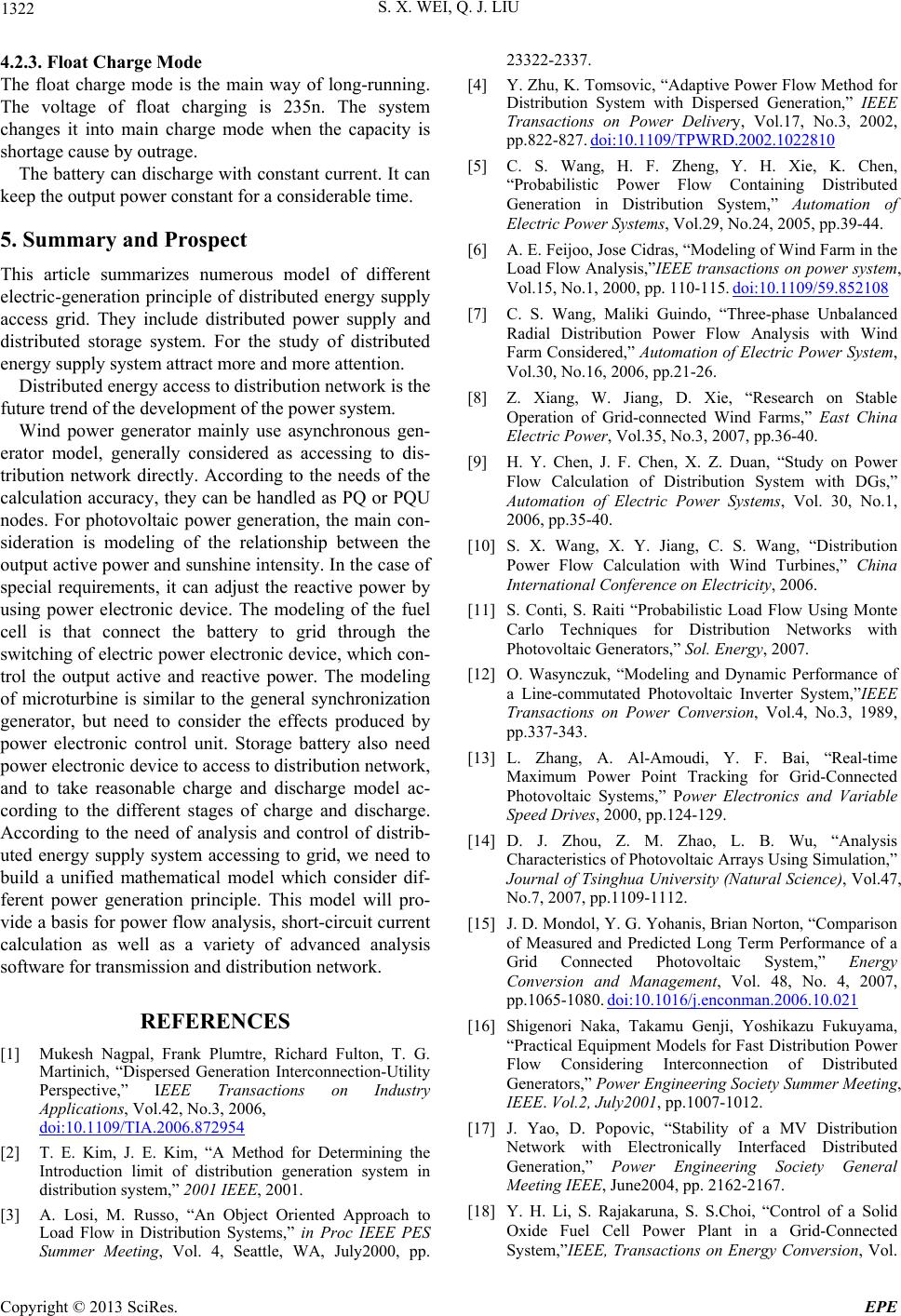
S. X. WEI, Q. J. LIU
1322
4.2.3. Float Charge Mo d e
The float charge mode is the main way of long-running
The voltage of float charging is 235n. The system
changes it into main charge mode when the capacity is
shortage cause by outrage.
The battery can discharge with constant current. It can
keep the output power constant for a considerable time.
5. Summary and P
merous model of different
more and more attention.
se asynchronous gen-
d as accessing to
.
rospect
This article summarizes nu
electric-generation principle of distributed energy supply
access grid. They include distributed power supply and
distributed storage system. For the study of distributed
energy supply system attract
Distributed energy access to distribution network is the
future trend of the development of the power system.
Wind power generator mainly u
erator model, generally considere
dis-
tribution network directly. According to the needs of the
calculation accuracy, they can be handled as PQ or PQU
nodes. For photovoltaic power generation, the main con-
sideration is modeling of the relationship between the
output active power and sunshine intensity. In the case of
special requirements, it can adjust the reactive power by
using power electronic device. The modeling of the fuel
cell is that connect the battery to grid through the
switching of electric power electronic device, which con-
trol the output active and reactive power. The modeling
of microturbine is similar to the general synchronization
generator, but need to consider the effects produced by
power electronic control unit. Storage battery also need
power electronic device to access to distribution network,
and to take reasonable charge and discharge model ac-
cording to the different stages of charge and discharge.
According to the need of analysis and control of distrib-
uted energy supply system accessing to grid, we need to
build a unified mathematical model which consider dif-
ferent power generation principle. This model will pro-
vide a basis for power flow analysis, short-circuit current
calculation as well as a variety of advanced analysis
software for transmission and distribution network.
REFERENCES
[1] Mukesh Nagpal, Frank Plumtre, Richard Fulton, T. G.
Martinich, “Dispersed Generation Interconnection-Utility
Perspective,” IEEE Transactions on Industry
Applications, Vol.42, No.3, 2006,
doi:10.1109/TIA.2006.872954
[2] T. E. Kim, J. E. Kim, “A Method for Determining the
Introduction limit of distribution generation system in
distribution system,” 2001 IEEE, 2001.
[3] A. Losi, M. Ru
Load Flow inin Proc IEEE P
Summer Meeting, Vol. 4, Seattle, WA, July2000, pp
, Vol.17, No.3, 2002,
D.2002.1022810
sso, “An Object Oriented Approach to
Distribution Systems,”
ES
.
23322-2337.
[4] Y. Zhu, K. Tomsovic, “Adaptive Power Flow Method for
Distribution System with Dispersed Generation,” IEEE
Transactions on Power Delivery
pp.822-827. doi:10.1109/TPWR
Automation of
[5] C. S. Wang, H. F. Zheng, Y. H. Xie, K. Chen,
“Probabilistic Power Flow Containing Distributed
Generation in Distribution System,”
Electric Power Systems, Vol.29, No.24, 2005, pp.39-44.
[6] A. E. Feijoo, Jose Cidras, “Modeling of Wind Farm in the
Load Flow Analysis,”IEEE transactions on power system,
Vol.15, No.1, 2000, pp. 110-115. doi:10.1109/59.852108
[7] C. S. Wang, Maliki Guindo, “Three-phase Unbalanced
Radial Distribution Power Flow Analysis with Wind
Farm Considered,” Automation of Electric Power System,
Vol.30, No.16, 2006, pp.21-26.
[8] Z. Xiang, W. Jiang, D. Xie, “Research on Stable
Operation of Grid-connected Wind Farms,” East China
Electric Power, Vol.35, No.3, 2007, pp.36-40.
[9] H. Y. Chen, J. F. Chen, X. Z. Duan, “Study on Power
Flow Calculation of Distribution System with DGs,”
Automation of Electric Power Systems, Vol. 30, No.1,
2006, pp.35-40.
[10] S. X. Wang, X. Y. Jiang, C. S. Wang, “Distribution
Power Flow Calculation with Wind Turbines,” China
International Conference on Electricity, 2006.
[11] S. Conti, S. Raiti “Probabilistic Load Flow Using Monte
Carlo Techniques for Distribution Networks with
Photovoltaic Generators,” Sol. Energy, 2007.
[12] O. Wasynczuk, “Modeling and Dynamic Performance of
a Line-commutated Photovoltaic Inverter System,”IEEE
Transactions on Power Conversion, Vol.4, No.3, 1989,
pp.337-343.
[13] L. Zhang, A. Al-Amoudi, Y. F. Bai, “Real-time
Maximum Power Point Tracking for Grid-Connected
Photovoltaic Systems,” Power Electronics and Variable
Speed Drives, 2000, pp.124-129.
[14] D. J. Zhou, Z. M. Zhao, L. B. Wu, “Analysis
Characteristics of Photovoltaic Arrays Using Simulation,”
Journal of Tsinghua University (Natural Science), Vol.47,
No.7, 2007, pp.1109-1112.
[15] J. D. Mondol, Y. G. Yohanis, Brian Norton, “Comparison
of Measured and Predicted Long Term Performance of a
Grid Connected Photovoltaic System,” Energy
Conversion and Management, Vol. 48, No. 4, 2007,
pp.1065-1080. doi:10.1016/j.enconman.2006.10.021
[16] Shigenori Naka, Takamu Genji, Yoshikazu Fukuyama,
“Practical Equipment Models for Fast Distribution Power
Flow Considering Interconnection of Distributed
Generators,” Power Engineering Society Summer Meeting,
IEEE. Vol. 2, July200 1, pp.1007-1012.
[17] J. Yao, D. Popovic, “Stability of a MV Distribution
Network with Electronically Interfaced Distributed
Generation,” Power Engineering Society General
Meeting IEEE, June2004, pp. 2162-2167.
[18] Y. H. Li, S. Rajakaruna, S. S.Choi, “Control of a Solid
Oxide Fuel Cell Power Plant in a Grid-Connected
Sys te m, ”IEEE, Transactions on Energy Conversion, Vol.
Copyright © 2013 SciRes. EPE